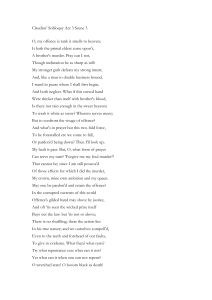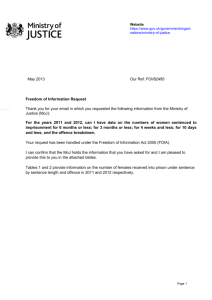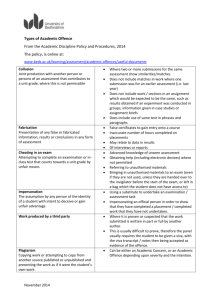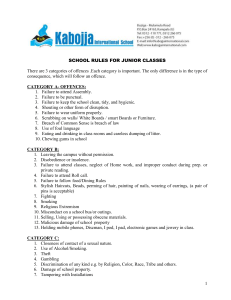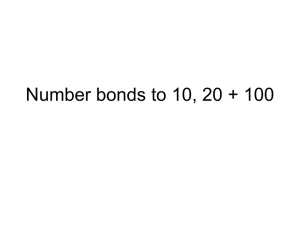Bonds, suspended sentences and reoffending
advertisement
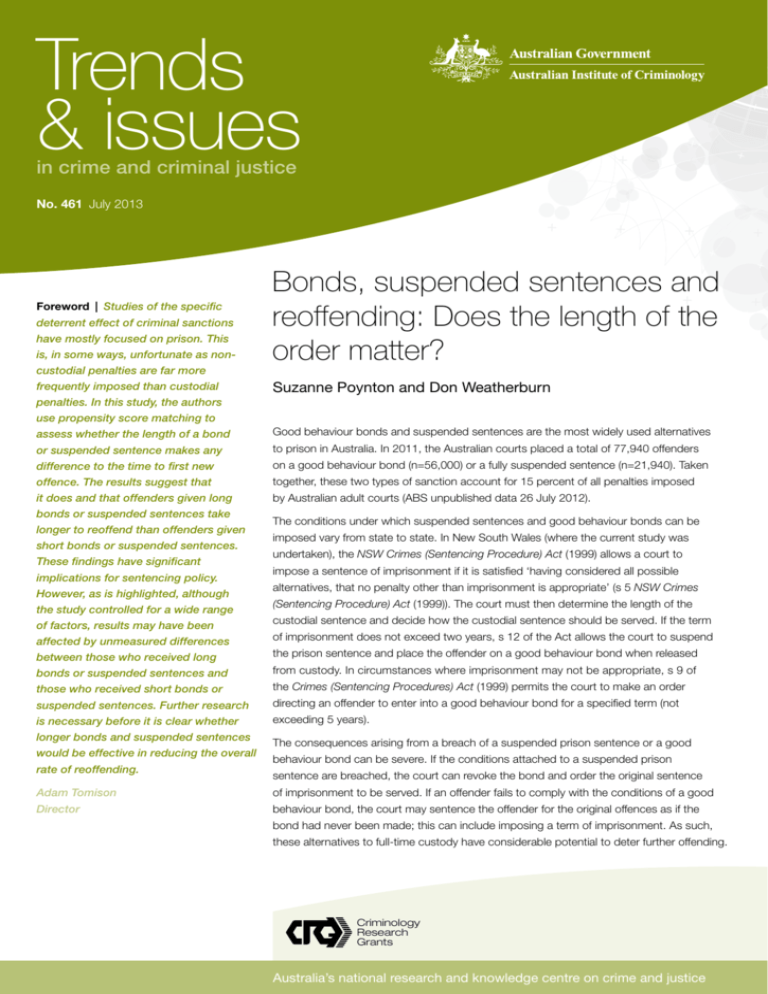
Trends & issues in crime and criminal justice No. 461 July 2013 Foreword | Studies of the specific deterrent effect of criminal sanctions have mostly focused on prison. This is, in some ways, unfortunate as noncustodial penalties are far more frequently imposed than custodial penalties. In this study, the authors use propensity score matching to assess whether the length of a bond or suspended sentence makes any difference to the time to first new offence. The results suggest that it does and that offenders given long bonds or suspended sentences take longer to reoffend than offenders given short bonds or suspended sentences. These findings have significant implications for sentencing policy. However, as is highlighted, although the study controlled for a wide range of factors, results may have been affected by unmeasured differences between those who received long bonds or suspended sentences and those who received short bonds or suspended sentences. Further research is necessary before it is clear whether longer bonds and suspended sentences would be effective in reducing the overall rate of reoffending. Bonds, suspended sentences and reoffending: Does the length of the order matter? Suzanne Poynton and Don Weatherburn Good behaviour bonds and suspended sentences are the most widely used alternatives to prison in Australia. In 2011, the Australian courts placed a total of 77,940 offenders on a good behaviour bond (n=56,000) or a fully suspended sentence (n=21,940). Taken together, these two types of sanction account for 15 percent of all penalties imposed by Australian adult courts (ABS unpublished data 26 July 2012). The conditions under which suspended sentences and good behaviour bonds can be imposed vary from state to state. In New South Wales (where the current study was undertaken), the NSW Crimes (Sentencing Procedure) Act (1999) allows a court to impose a sentence of imprisonment if it is satisfied ‘having considered all possible alternatives, that no penalty other than imprisonment is appropriate’ (s 5 NSW Crimes (Sentencing Procedure) Act (1999)). The court must then determine the length of the custodial sentence and decide how the custodial sentence should be served. If the term of imprisonment does not exceed two years, s 12 of the Act allows the court to suspend the prison sentence and place the offender on a good behaviour bond when released from custody. In circumstances where imprisonment may not be appropriate, s 9 of the Crimes (Sentencing Procedures) Act (1999) permits the court to make an order directing an offender to enter into a good behaviour bond for a specified term (not exceeding 5 years). The consequences arising from a breach of a suspended prison sentence or a good behaviour bond can be severe. If the conditions attached to a suspended prison sentence are breached, the court can revoke the bond and order the original sentence Adam Tomison of imprisonment to be served. If an offender fails to comply with the conditions of a good Director behaviour bond, the court may sentence the offender for the original offences as if the bond had never been made; this can include imposing a term of imprisonment. As such, these alternatives to full-time custody have considerable potential to deter further offending. Criminology Research Grants Australia’s national research and knowledge centre on crime and justice In 2010, over a half (54%) of the suspended receive it. Individuals are matched on the Outcome variables sentences and about a third (32%) of the basis of a propensity score. A propensity good behaviour bonds imposed by NSW score is the conditional probability of The reoffending outcome used in this study Local Courts required some form receiving the treatment given a set of of supervision (NSW BOCSAR 2011). observed covariates. Outcomes (eg The Probation and Parole Service provides reoffending) are then compared between various levels of support for offenders matched groups (for further detail on under their supervision. Offenders who the technique see Apel & Sweeten 2010). are assessed to be at serious risk of was time to first new offence. This equated to the number of days that elapsed between the offender receiving the suspended sentence or bond (ie index appearance date) and the date of the first subsequent offence. In cases where no offences were recorded during the observation period, the reoffending may be required to participate Data source in rehabilitation programs designed to Data for this study were extracted from the reduce further offending, such as drug and the end of the three year follow-up Bureau of Crime Statistic and Research’s and alcohol treatment or education and period was calculated. Time to first new Reoffending Database (see Fitzgerald & Hua training programs. Participation in these offence was adjusted for any time spent 2006). This database contains records of programs may also be a condition of the in custody during the follow-up period. all persons appearing before the NSW local bond stipulated by the court. Suspended and higher courts who have been charged Explanatory variables sentences and good behaviour bonds with a criminal offence since 1994. It includes might therefore also be expected to have both information about the charge (eg offence The explanatory variables are listed and a rehabilitative effect on offenders. type, concurrent offences, plea, outcome and Despite the popularity of bonds and suspended sentences and their potential to reduce further offending, no study to date has examined the question of whether penalty) and information about the offender (eg age, gender, last postcode and race). Each court record is linked, thus allowing individual offenders to be tracked over time. the length of the order (ie bond length or To examine the effect of suspended suspended sentence length) influences sentences and good behaviour bonds on the risk of reoffending. reoffending, two cohorts of offenders were The current study was designed to address the following key research questions: • Are long bonds more effective than short bonds in reducing reoffending? • Does supervision make a difference to this effect? • Are long suspended sentences more identified from the Reoffending Database reoffending? • Does supervision make a difference to this effect? Method Propensity score matching (PSM) was employed to match all groups being compared. In PSM, individuals who receive a treatment (eg long bond or long suspended sentence) are matched with untreated individuals who are equally likely to receive the treatment but who did not 2 | Australian Institute of Criminology • gender—gender of defendant; • Socio-Economic Indexes for Areas (SEIFA) quartile; • remoteness—the Australian Bureau of Statistics’ Area of Remoteness Index for the offender’s postcode; • plea—plea issued by defendant for suspended sentence for their principal the principal offence at the index court offence in the NSW Local Court between appearance; 2006 and 2008. The second cohort consisted of all offenders who received a good behaviour bond for their principal 2006 and 2008. The cut-off date for long suspended sentences in reducing (in whole years); consisted of all offenders who received a in reducing reoffending? • Are long bonds more effective than • age—age at date of index appearance • year of finalisation of index offence; offence in the NSW Local Court between this effect? described below: and relevant data extracted. The first cohort effective than short suspended sentences • Does supervision make a difference to time between the index court appearance inclusion in the study was 31 December 2008. This allowed all offenders to be followed up for three years after finalisation of their index offence. • concurrent offences—number of proven concurrent charges at index court appearance (excluding principal offence); • legal representation—whether or not the defendant was legally represented at the index court appearance; • bail—bail status of the defendant at the index court appearance; • offence seriousness—an index of Independent variable offence seriousness of the principal The key independent variable of interest in offence at index appearance based on this research was the length of suspended the Median Sentence Ranking method sentence or good behaviour bond issued developed by MacKinnell, Poletti and at the index court appearance. A long Holmes (2010); good behaviour bond was defined as a supervised or unsupervised bond that was 24 months or longer in duration. A long suspended sentence was defined as a supervised or unsupervised suspended sentence that was 12 months or longer in duration. • penalty type—the type of penalty at the index court appearance; • counts—number of counts of principal offence at index court appearance; • offence type—whether the principal offence at the index court appearance was a(n): –– homicide or related offence; Propensity score methods Log Rank, Mantel-Cox=120.195; p<.001) –– act intended to cause injury; The psmatch2 module in STATA/IC was compared with offenders who received –– sexual assault offence; used to conduct PSM (Leuven & Sianesi short bonds. –– dangerous or negligent act endangering persons; 2003). The analysis involved one-to- Table 2 presents the number and –– abduction, harassment or other offence against the person; no replacement and a calliper of 0.05. –– robbery or extortion offence; matched with the untreated offender if their one nearest neighbour matching with This means that a treated offender was –– burglary or break and enter offence; propensity scores were within 0.05 units –– theft offence; of each other. –– fraud, deception or related offence; –– illicit drug offence; –– prohibited or regulated weapons or explosive offence; –– property damage or environmental pollution offence; –– public order offence; percentage of offenders with a suspended sentence (n=15,129) who reoffended within three years of their index court appearance by the length of the suspended sentence imposed for the principal offence. The unadjusted mean number of days to first Cox regression was used to compare the new offence for the suspended sentence time to first new offence. This reoffending group is also shown here. Again, there was outcome was modelled without and with a significant bivariate relationship between adjustment for other potential covariates. sentence length and the likelihood of reoffending. Offenders who received Results long suspended sentences (of 12 months or more) were less likely to be found guilty –– low or special range Prescribed Concentration of Alcohol (PCA) offence; Descriptive statistics of a new offence within the three year follow-up period (Chi-square=49.066; –– mid or high-range PCA offence; Table 1 shows the percentage of offenders with a good behaviour bond (n=52,932) p<.001) and on average, took longer to who reoffended within three years of their reoffend (mean=704.1; Log Rank, Mantel- index court appearance by the length of Cox=58.439; p<.001) than offenders who the bond imposed for their principal offence. received short suspended sentences. –– other traffic and vehicle regulatory offence; –– justice procedure offence; –– other offence. • prior court finalisations—number of finalised court appearances for a proven offence prior to the index court appearance; • prior juvenile record—whether the The unadjusted mean number of days from the index appearance to first new offence for the bond group is also shown in Table 1. As can be seen, there is a significant bivariate relationship between sentence length and both the likelihood of reoffending defendant had appeared before the and the time to first new offence. Offenders Children’s Court or attended a Youth who received long bonds were less likely Justice Conference prior to the index court appearance; • prior penalty type—whether the defendant had received any of the to be reconvicted of an offence within three years of their index court appearance (Chisquare=115.616; p<.001) and on average, took longer to reoffend (mean=782.9; following court imposed penalties prior to the index court appearance; –– full-time prison sentence; –– good behaviour bond; –– suspended sentence; –– periodic detention. • prior offence type—whether the defendant had been found guilty of any of the following offences prior to the index court appearance –– property offence; –– violence offence; –– drug offence; –– PCA offence; –– other driving offence; –– breach of a court order. Long versus short good behaviour bonds Table 3 presents the results of the Cox regression modelling for the bond sample after matching on propensity scores (n=26,650). A hazard ratio of more than one indicates that the instantaneous risk of reoffending is higher for offenders given long bonds and a hazard ratio less than one indicates that the instantaneous risk of reoffending is less for offenders given long bonds. Table 1 Reoffending outcomes for short and long bond groups, unmatched (n=52,932) 0 to 23 months 24+ months p Reoffended within 36 months Percent 47.8 42.5 <.001 737.4 782.9 <.001 Number of days to first new offence Mean Table 2 Reoffending outcomes for short and long suspended sentence groups, unmatched (n=15,129) 0 to 11 months 12+ months p Reoffended within 36 months Percent 58.1 52.3 <.001 646.7 704.1 <.001 Number of days to first new offence Mean Australian Institute of Criminology | 3 The hazard ratio associated with treatment was a significant effect of bond length on show that after matching offenders on their group was 0.921 (95% Confidence Interval the time to first new offence (Hazard Ratio propensity scores, there was no significant 0.888, 0.954) and was also significant 0.900; p<.001). This significant difference effect of sentence length on the time to (p<.001). This indicates that treated remained even after adjusting for covariates. first new offence (p=0.096). There was, offenders were eight percent less likely For matched offenders who received a court- however, some evidence for a significant to reoffend at any given time compared imposed bond without supervision, there was difference in reoffending between offenders with untreated offenders. The hazard ratio also a significant effect of bond length on the given long and short suspended sentences associated with the treatment group variable time to first new offence (Hazard Ratio 0.930, after adjusting for relevant covariates. Net remained significant even after adjusting for p=0.003). This difference was significant with of controls, offenders given long suspended relevant covariates in the reoffending models and without covariate adjustment. These sentences took, on average, longer to (Hazard Ratio=0.905, p<.001). results indicate that both supervised and reoffend (Hazard Ratio=0.919, p=0.002) unsupervised offenders who received long compared with offenders given short bonds took longer, on average, to reoffend suspended sentences. Supervised and unsupervised bonds than offenders who received short bonds. Table 4 presents the outcomes from the Supervised and unsupervised suspended sentences and unsupervised bond groups after Reoffending: Long versus short suspended sentences matching on propensity scores. For the Table 5 presents the results of the Cox reoffending analyses for the supervised and offender group who received a court regression modelling for the suspended unsupervised suspended sentence groups imposed bond with supervision, there sentence sample (n=9,594). These analyses after matching on propensity scores. For the reoffending analyses for the supervised Table 6 presents the outcomes from the offender group who received a suspended sentence with supervision, there was no Table 3 Reoffending for short and long bond groups, matched (n=26,650) 0 to 23 months 24+ months p 95% CIa Time to first new offence significant effect of sentence length on the time to first new offence (p=0.292), with or without adjustment for covariates. For Unadjusted hazard ratio 1.00 0.921 <.001 0.888–0.954 1.00 0.905 <.001 0.873–0.939 Number of days to first new offence Adjustedb hazard ratio matched offenders who received a suspended sentence without supervision, there was also no significant effect of a: Standard errors have been adjusted to account for matched nature of the data sentence length on the time to new offence b: Adjusted for demographic, offence and prior offending variables (p=0.443), with or without adjustment for other covariates. Table 4 Reoffending for short and long bond groups by type of order, matched Bond with supervision (n=10,150)b Long bonds versus long suspended sentences Time to first new offence Given the significant effect of sentence 0 to 23 months 24+ months p 95% CIa Unadjusted hazard ratio 1.00 0.900 <.001 0.853–0.949 length on reoffending for both the bond Adjusted hazard ratio 1.00 0.883 <.001 0.836–0.933 and suspended sentence groups, further c analyses were undertaken to investigate Bond without supervision (n=16,438)b whether long suspended sentences are Time to first new offence Unadjusted hazard ratio 1.00 0.930 0.003 0.886–0.976 Adjustedc hazard ratio 1.00 0.919 0.001 0.876–0.965 a: Standard errors have been adjusted to account for matched nature of the data b: 17 cases from the supervised bond sample and 5 cases from the unsupervised bond sample were dropped from the survival analysis because the time to first new offence was zero after adjusting for time spent in custody reoffending. Only offenders given a long suspended sentence (defined as 12 months or more) or long bond (defined as 24 months or more) were included in this analysis. c: Adjusted for demographic, offence and prior offending variables Table 5 Reoffending for short and long suspended sentence groups, matched (n=9,594) 0 to 11 months more effective than long bonds in reducing 12+ months p 95% CIa Time to first new offence Unadjusted hazard ratio 1.00 0.956 0.096 0.906–1.008 Adjustedb hazard ratio 1.00 0.919 0.002 0.871–0.971 Table 7 presents the outcomes from the reoffending analyses for the long suspended sentence and long bond groups after matching on propensity scores. After matching, there were no significant differences between the long suspended a: Standard errors have been adjusted to account for matched nature of the data sentence and long bond groups in the time b: Adjusted for demographic, offence and prior offending variables to first offence (p=0.062), with and without adjustment for covariates. 4 | Australian Institute of Criminology Table 8 presents the outcomes from the The p-value did not reach the conventional Taken overall, these findings support the reoffending analyses for the supervised level of statistical significance but the hypothesis that offenders placed on long and unsupervised long bonds and long adjusted comparison was close to (24 month plus) bonds or long (12 month suspended sentence groups after matching significant (see Table 7; Hazard Ratio=0.941, plus) suspended sentences are less likely on propensity scores. For both the p=0.054). Given the sample on which these to reoffend than offenders placed on short supervised and unsupervised cohorts, comparisons are based (n=8,094) was bonds or short suspended sentences. It is there were no significant differences between very large, it seems unlikely that further important to note, however, that although a the bond and suspended sentence groups increases in sample size would render these large number of factors known to influence in the time to first new offence, with and comparisons significant. bond/suspended sentence length and without adjustment for covariates. Table 6 Reoffending for short and long suspended sentence groups by type of order, matched Discussion 0 to 23 months 24+ months p 95% CIa The main aim of the current study was Suspended sentence with supervision (n=5,582)b to examine the effect of order length on Time to first new offence reoffending among offenders placed on Unadjusted hazard ratio 1.00 0.964 0.292 0.902–1.032 good behaviour bonds and suspended Adjusted hazard ratio 1.00 0.946 0.116 0.884–1.014 sentences. A secondary aim was to Suspended sentence without supervision (n=3,934)b determine whether supervision moderated Time to first new offence the effects of order length. The evidence presented in this report shows that after adjustment for other factors, the time to first new offence in the three year period following imposition of a bond was lower for those on bonds 24 months and longer. Supervision made no difference to this result. After adjustment for other factors, the time to first new offence was also lower for those on long (12 month plus) suspended c Unadjusted hazard ratio 1.00 0.967 0.443 0.886–1.054 Adjusted hazard ratio 1.00 0.928 0.102 0.849–1.015 c a: Standard errors have been adjusted to account for matched nature of the data b: 21 cases from the supervised suspended sentence sample and 7 cases from the unsupervised suspended sentence sample were dropped from the survival analysis because the time to first new offence was zero after adjusting for time spent in custody Table 7 Reoffending outcomes for long bonds and long suspended sentence groups, matched (n=8,094) Reoffending outcome Long bonds Long suspended sentences 95% CIa p sentences. However, no significant effect Time to first new offence of sentence length was observed when Unadjusted hazard ratio 1.00 0.944 0.062 0.889–1.003 separate analyses were conducted for Adjustedb hazard ratio 1.00 0.941 0.054 0.885–1.001 suspended sentences with supervision and suspended sentences without supervision. This is probably a result of reduced statistical power. The number of matched cases involving suspended sentences with and without a: Standard errors have been adjusted to account for matched nature of the data b: Adjusted for demographic, offence and prior offending variables Table 8 Reoffending outcomes for long bonds and long suspended sentence groups by type of order, matched supervision was substantially smaller than the number of matched cases involving bonds with and without supervision. Given that the effect of sentence length was Long bonds and unsupervised suspended sentences Adjusted hazard ratio were combined into one analysis, it is Without supervision (n=3,556) not surprising that the effect disappeared Time to first new offence The comparison of long bonds with long suspended sentences produced very weak evidence that offenders on long suspended sentences took longer to reoffend than 95% CIa Time to first new offence Unadjusted hazard ratio sentence were analysed separately. p With supervision (n=4,380)b comparatively small when supervised altogether when the two types of suspended Long suspended sentences 1.00 0.935 0.106 0.863–1.014 1.00 0.948 0.204 0.872–1.030 Unadjusted hazard ratio 1.00 0.952 0.338 0.860–1.053 Adjusted hazard ratio 1.00 0.949 0.319 0.856–1.052 c b c a: Standard errors have been adjusted to account for matched nature of the data b: 15 cases from the supervised sample and 2 cases from the unsupervised sample were dropped from the survival analysis because the time to first new offence was zero after adjusting for time spent in custody c: Adjusted for demographic, offence and prior offending variables similar offenders placed on long bonds. Australian Institute of Criminology | 5 Dr Don Weatherburn and Dr Suzanne Poynton are from the NSW Bureau of Crime Statistics and Research. This study was funded by the Criminology Research Council. General editor, Trends & issues in crime and criminal justice series: Dr Adam M Tomison, Director, Australian Institute of Criminology Note: Trends & issues in crime and criminal justice papers are peer reviewed For a complete list and the full text of the papers in the Trends & issues in crime and criminal justice series, visit the AIC website at: http://www.aic.gov.au ISSN 0817-8542 (Print) 1836-2206 (Online) © Australian Institute of Criminology 2013 GPO Box 2944 Canberra ACT 2601, Australia Tel: 02 6260 9200 Fax: 02 6260 9299 Disclaimer: This research paper does not necessarily reflect the policy position of the Australian Government CRG no. 02/11–12 reconviction have been controlled for, it is always possible some omitted variable is responsible for the observed relationship between length and reoffending. This model, for example, does not include The third possibility is to change the law so controls for an offender’s level of support as to permit longer bonds and suspended in the community or the extent of their sentences. If such a change resulted in remorse. Either or both of these factors longer bonds and suspended sentences, may influence penalty choice and/or risk it would create the conditions for a natural of reoffending. experiment. In other words, it would make There are only three ways to conduct a stronger test of the effect of long bonds and long suspended sentences on risk of reoffending. The first is to conduct a randomised trial in which a large group it possible to examine rates of reoffending before and after the change while controlling for any differences in the characteristics of offenders receiving bonds and suspended sentences before and after the change. of offenders are randomly allocated A change in sentencing law for this purpose to short and long bonds/suspended might be considered unlikely, but there are sentences. Such a study would seem other justifications for reform in this area. As unlikely to gain ethical approval as it the NSW Law Reform Commission recently would involve subjecting offenders pointed out (NSW LRC 2012), at present in to different sanctions solely on the New South Wales, a court cannot impose basisof chance. a short suspended sentence in conjunction The second possibility is to find a variable that influences penalty selection but has no direct effect on risk of reoffending. This would permit the use of two-stage least squares analysis and other similar techniques that control for both omitted and observable factors. The challenge here lies in finding such a variable. The one variable that might meet this requirement is magistrate/judge severity. If judicial officers differ in their proclivity to impose long bonds or suspended sentences and if that proclivity is unrelated to reoffending other than by way of its effect on the penalty received, it may be possible to conduct a more stringent test of the hypothesis that long bonds and long suspended sentences reduce the risk of reoffending. www.aic.gov.au with a long s 12 good behaviour bond (the bond imposed when a prison sentence is suspended). This constraint has been the subject of judicial criticism (NSW LRC 2012). Indeed, in a 2011 survey of judicial officers carried out by the NSW Sentencing Council, 62 percent of those surveyed were in favour of increasing the maximum length of a s 12 bond. Eighty-two percent were in favour of changing the law so that a s 12 bond of greater length than a suspended sentence could be imposed (NSW LRC 2012). Acknowledgements This study was funded by the Criminology Research Council. The authors thank WaiYin Wan and Steve Moffatt for their valuable advice on the methodology used for this paper. References All URLs correct at May 2013 Apel RJ & Sweeten G 2010. Propensity score matching in criminology and criminal justice, in Piquero AR& Weisburd D (eds), Handbook of quantitative criminology. New York: Springer: 543–562 Fitzgerald J & Hua J 2006. Matching court records to measure reoffending. Crime & Justice Bulletin no. 95. Sydney: NSW Bureau of Crime Statistics and Research Leuven E & Sianesi B 2003. PSMATCH2: Stata module to perform full Mahalanobis and propensity score matching, common support graphing, and covariate imbalance testing. http:// ideas.repec.org/c/boc/bocode/s432001.html MacKinnell I, Poletti P & Holmes M 2010. Measuring offence seriousness. Crime & Justice Bulletin no. 136. Sydney: NSW Bureau of Crime Statistics and Research NSW Bureau of Crime Statistics and Research (NSW BOCSAR) 2011. NSW criminal court statistics 2010. Sydney: NSW BOCSAR NSW Law Reform Commission (NSW LRC) 2012. Intermediate custodial sentencing options. Sentencing question paper 6. http://www. lawreform.lawlink.nsw.gov.au/lrc/lrc_publications/ lrc_questionpapers.html
